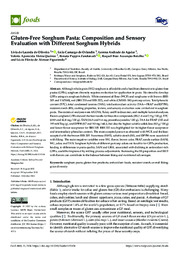Gluten-free sorghum pasta: composition and sensory evaluation with different sorghum hybrids.
Gluten-free sorghum pasta: composition and sensory evaluation with different sorghum hybrids.
Author(s): OLIVEIRA, L. de L. de; ORLANDIN, L. C. de; AGUIAR, L. A. de; QUEIROZ, V. A. V.; ZANDONADI, R. P.; BOTELHO, R. B. A.; FIGUEIREDO, L. F. de A.
Summary: Although whole grain (WG) sorghum is affordable and a healthier alternative to gluten-free pastas (GFPa), sorghum diversity requires evaluation for application in pasta. We aimed to develop GFPa using six sorghum hybrids. White commercial flour (WCF) and sorghums with brown (BRS 305 and 1167048), red (BRS 330 and BRS 332), and white (CMSXS 180) pericarp colors. Total phenolic content (TPC), total condensed tannins (TAN), total antioxidant activity (TAA?FRAP and DPPH), resistant starch (RS), cooking properties, texture, and sensory evaluation were carried out in sorghum pasta. The statistical analyses were ANOVA, Tukey and Friedman test, and multiple factorial analyses. Brown sorghum GFPa showed the best results for bioactive compounds (RS (1.8 and 2.9 g/100 g), TPC (69.9 and 42.8 mg/100 g), TAN (16.9 and 9.4 mg proanthocyanidin/100 g), TAA for FRAP (305 and 195 mM Teq/g), and DPPH (8.7 and 9.0 mg/mL)), but also the highest soluble solids loss (8.0 g/100 g) and lower flavor acceptance for BRS 305. BRS 332 was highlighted for its higher flavor acceptance and intermediary phenolics content. The most accepted pasta was obtained with WCF, and the least accepted with the brown BRS 305. Sweetness (SWE), soluble starch (SS), and DPPH were associated with liking. The main negative variables were WG_flavor, brown color, FRAP, sandy surface (SAN), WG_odor, and TAN. Sorghum hybrids of different pericarp colors are feasible for GFPa production, leading to differences in pasta quality. SAN and GRA, associated with disliking in antioxidant-rich GFPa, could be improved by milling process adjustments. Increasing the SS proportion and SWE with flavors can contribute to the balance between liking and nutritional advantages.
Publication year: 2022
Types of publication: Journal article
Unit: Embrapa Maize & Sorghum
Keywords: Alimento, Amido, Antioxidante, Glúten, Sorgo
Observation
Some of Embrapa's publications are published as ePub files. To read them, use or download one of the following free software options to your computer or mobile device. Android: Google Play Books; IOS: iBooks; Windows and Linux: Calibre.
Access other publications
Access the Agricultural Research Database (BDPA) to consult Embrapa's full library collection and records.
Visit Embrapa Bookstore to purchase books and other publications sold by Embrapa.

